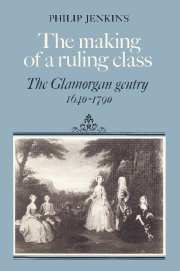Book contents
- Front matter
- Contents
- List of maps and tables
- Acknowledgments
- Abbreviations
- General introduction
- PART I SOCIAL AND ECONOMIC STRUCTURE
- PART II LOCAL AND NATIONAL POLITICS
- PART III SOCIETY AND CULTURE
- Conclusion to Part III: ‘conspicuous antiquity’
- Aftermath: towards the Victorian world
- Conclusion: from Civil War to Industrial Revolution
- Appendix 1 Parliamentary service by Glamorgan landowners 1640 – 1800
- Appendix 2 The ‘secondary’ gentry families
- Appendix 3 The ‘tertiary’ families
- Appendix 4 The Mansell family and their connections with the greater gentry
- Appendix 5 The roundhead and puritan family links of the Thomases of Wenvoe
- Notes
- Index
General introduction
Published online by Cambridge University Press: 22 September 2009
- Front matter
- Contents
- List of maps and tables
- Acknowledgments
- Abbreviations
- General introduction
- PART I SOCIAL AND ECONOMIC STRUCTURE
- PART II LOCAL AND NATIONAL POLITICS
- PART III SOCIETY AND CULTURE
- Conclusion to Part III: ‘conspicuous antiquity’
- Aftermath: towards the Victorian world
- Conclusion: from Civil War to Industrial Revolution
- Appendix 1 Parliamentary service by Glamorgan landowners 1640 – 1800
- Appendix 2 The ‘secondary’ gentry families
- Appendix 3 The ‘tertiary’ families
- Appendix 4 The Mansell family and their connections with the greater gentry
- Appendix 5 The roundhead and puritan family links of the Thomases of Wenvoe
- Notes
- Index
Summary
To explain the purpose of this book, a short autobiographical excursus is required. The origins of the book lie at least five years before I began undertaking the research on which it is based: they lie in a summer of the late 1960s when, in the space of a few days, I discovered that Glamorgan possessed two of the finest monuments in Britain from the period we call ‘early modern’. The first I encountered was the Mansell series of tombs in Margam Abbey, which dates from between 1560 and 1640. It is the last tomb in the series (that of Sir Lewis Mansell) which is of such quality that it may fairly be set beside any piece of art in Britain from that outstanding century. The second ‘find’ was the deserted roofless manor house of Beaupre (pronounced Bewper), which stands almost forgotten in the rolling meadows south of Cowbridge, the countryside often called ‘The Garden of Wales’ (less restrained local patriots drew comparison with Arcadia or Eden, but ‘Garden’ will suffice). The house's best feature was a two-storied columned porch in the ‘English Renaissance’ style of about 1600, and it was quite magnificent. I have never seen a photograph which succeeded in catching or defining its splendour, and its image remained with me when in later years I was pursuing more serious historical studies.
But these artifacts also raised difficult historical questions.
Information
- Type
- Chapter
- Information
- The Making of a Ruling ClassThe Glamorgan Gentry 1640–1790, pp. xv - xxviPublisher: Cambridge University PressPrint publication year: 1983
